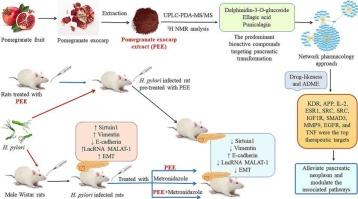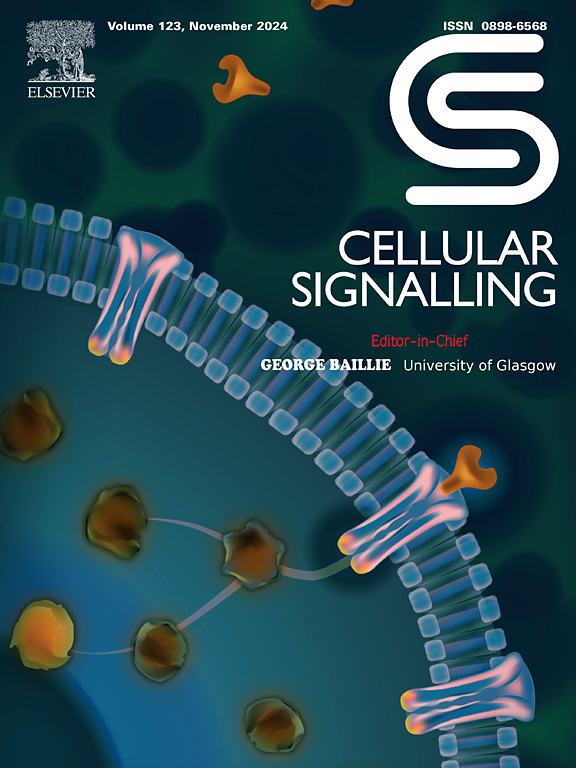石榴外果皮提取物对幽门螺杆菌诱导的胰腺 EMT 的影响:分子机制和治疗潜力。
IF 4.4
2区 生物学
Q2 CELL BIOLOGY
引用次数: 0
摘要
背景:先前的研究表明幽门螺杆菌感染与胰腺疾病(包括癌症)有关:目的:探讨石榴外果皮提取物(PEE)对幽门螺杆菌诱导的胰腺大鼠组织上皮-间质转化(EMT)的影响,并揭示其潜在的分子机制:28只大鼠分为6组:第1组(阴性对照)、第2组(幽门螺杆菌感染)、第3组(感染+PEE预处理)、第4组(感染+PEE治疗)、第5组(感染+甲硝唑治疗)和第6组(感染+甲硝唑/PEE联合治疗):本研究旨在评估石榴外果皮提取物(PEE)治疗 Wistar 大鼠幽门螺杆菌感染及其相关胰腺组织变化的效果。研究将48只雄性大鼠分为六组:幽门螺杆菌感染对照组、PEE预防组、PEE治疗组、甲硝唑治疗组、PEE联合甲硝唑治疗组和阴性对照组。结果显示,与阳性对照组相比,PEE 治疗组胃窦中的幽门螺杆菌浓度明显降低(27.08 %)(p本文章由计算机程序翻译,如有差异,请以英文原文为准。

Effects of pomegranate exocarp extract on H. pylori-induced pancreatic EMT: Molecular mechanisms and therapeutic potential
Background
Previous studies have linked Helicobacter pylori infection with pancreatic diseases, including cancer.
Purpose
To explore the influence of pomegranate exocarp extract (PEE) on epithelial-mesenchymal transition (EMT) in H. pylori-induced pancreatic rat tissue and to uncover the underlying molecular mechanisms.
Study design
Twenty-eight rats were divided into six groups: group 1 (negative control), group 2 (H. pylori-infected), group 3 (infected + PEE pretreatment), group 4 (infected + PEE treatment), group 5 (infected + metronidazole treatment), and group 6 (infected + metronidazole/PEE co-treatment).
Methods and results
This study aimed to assess the effectiveness of pomegranate exocarp extract (PEE) in treating Helicobacter pylori infection and its associated pancreatic tissue changes in Wistar rats. The study involved Forty-eight male rats divided into six groups: H. pylori-infected control, PEE-preventive, PEE treatment, metronidazole treatment, PEE combined with metronidazole treatment, and negative control. The results showed a significant reduction in H. pylori concentration in the antrum in the PEE-treated groups (27.08 %) compared to that in the positive control group (p < 0.05). The group receiving the combined treatment exhibited the highest reduction (55.8 %) in H. pylori concentration (p < 0.005), with no significant difference observed between the PEE-preventive and metronidazole-treated groups. The ELISA results showed that the groups treated with PEE, PEE-preventive, and PEE combined with metronidazole experienced a significant increase in pancreatic E-cadherin levels by 47.7 %, 73.8 %, and 118.06 % respectively, and a substantial decrease in vimentin levels by 16.6 %, 31.6 %, and 43.5 % respectively, compared to the positive control group (p < 0.05). The results of the RT-qPCR analysis showed that the PEE treatment group, as well as the PEE preventive and PEE combined with metronidazole treatment groups, displayed significant downregulation of vimentin, sirtuin1, and lncRNA MALAT-1, and upregulation of E-cadherin compared to the positive control group. However, there was no significant difference between the PEE-preventive and metronidazole-treated groups (p < 0.05). Histopathological analysis showed considerable improvement in pancreatic tissue morphology in the PEE-treated groups. The inflammation score was significantly lower in these groups (p < 0.05), and the combined treatment group exhibited minimal signs of metaplasia and mononuclear cell infiltration. A computational study identified 54 human target genes of bioactive compounds in PEE. These findings shed light on the crucial interactions and pathways in treating pancreatic tumors. Additionally, GO enrichment and KEGG pathway analyses revealed significant pathways, such as the MAPK signaling and RTK pathway, enriched with genes targeted by PEE. Furthermore, evaluation of drug-likeness and ADME properties indicated that ellagic acid possesses drug-like properties and has a high potential for oral absorption. In conclusion, PEE has shown significant therapeutic potential in reducing H. pylori load and improving pancreatic tissue health while influencing key molecular markers and pathways associated with pancreatic tumors.
求助全文
通过发布文献求助,成功后即可免费获取论文全文。
去求助
来源期刊

Cellular signalling
生物-细胞生物学
CiteScore
8.40
自引率
0.00%
发文量
250
审稿时长
27 days
期刊介绍:
Cellular Signalling publishes original research describing fundamental and clinical findings on the mechanisms, actions and structural components of cellular signalling systems in vitro and in vivo.
Cellular Signalling aims at full length research papers defining signalling systems ranging from microorganisms to cells, tissues and higher organisms.
 求助内容:
求助内容: 应助结果提醒方式:
应助结果提醒方式:


